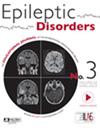HCN1 pathogenic variants associated with childhood epilepsy in a cohort of Chinese patients
Abstract
Objective
HCN ion channel family has a widespread expression in neurons, and recently, increasing studies have demonstrated their roles in epilepsies.
Methods
Clinical data of the patients were gathered in a retrospective study. Exon sequencing was used for the patients with unexplained recurrent seizures and varying levels of developmental delay.
Results
In this study, eight de novo variants of HCN1 genes were uncovered in eight patients, including six missense variants, one nonsense variant and one frameshift insertion variant; five of them were reported for the first time. The onset age for eight patients ranges from one month to one year. Their main clinical manifestations are epilepsy and varying degrees of developmental delay, and the main type of seizure is focal secondary generalized tonic–clonic seizure. Importantly, in our study, one case presented with a form of migrating focal seizure that has not been reported in the literature. Seizures from five of the eight children were effectively controlled with antiepileptic drugs including valproic acid, levetiracetam and oxcarbazepine. One child developed normally and four children developed mild delay. One child was treated with topiramate, and the convulsion was partially controlled and showed moderate to severe developmental delay. The antiepileptic treatment failed for the other two children, and the two children were treated with sodium valproate, oxcarbazepine, lamotrigine, chlorbazan, levetiracetam and nitrodiazepam successively, but their convulsions were not controlled and showed moderate to severe developmental delay.
Significance
Our research reported eight variants in HCN1 gene causing epilepsy; among these variants, five variants were never reported before. HCN1-related epilepsy usually starts infantile period, and focal secondary generalized tonic–clonic seizure is the most common seizure type. Importantly, we reported the case with migrating focal seizure was rarely reported. Our study expanded both genotype and phenotype for HCN1-related epilepsy.

 求助内容:
求助内容: 应助结果提醒方式:
应助结果提醒方式:


